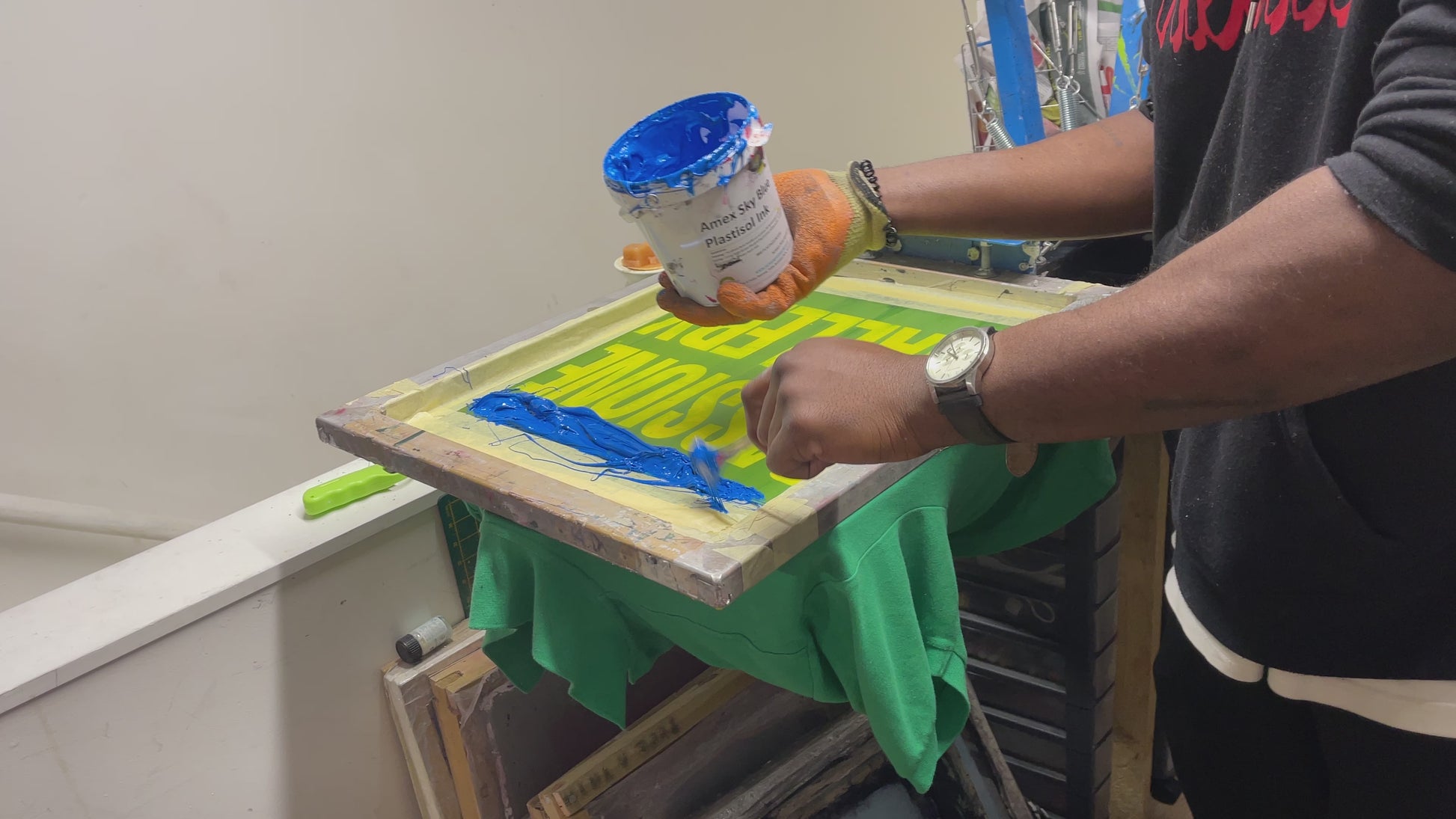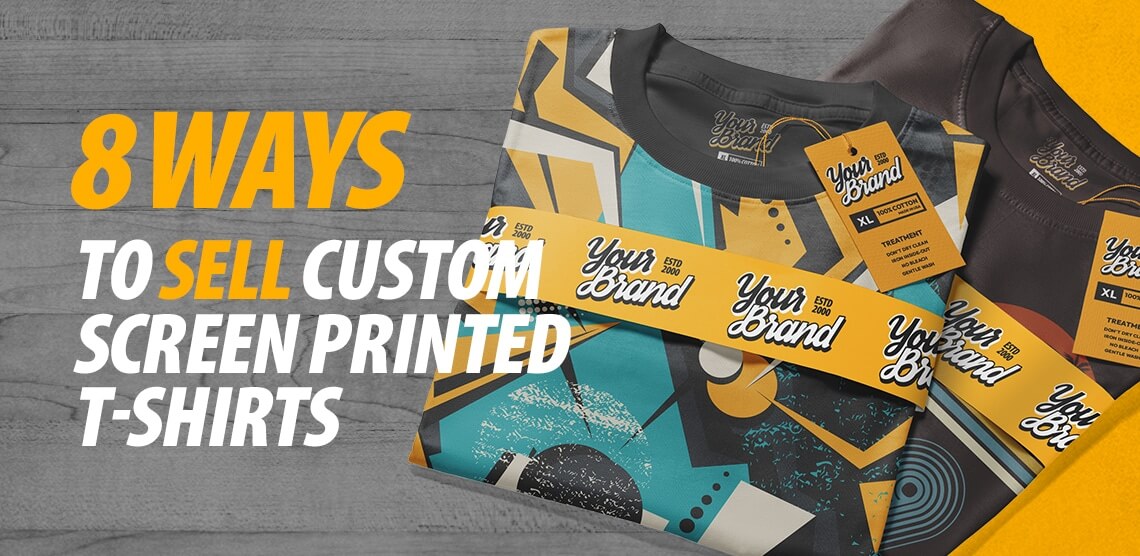High-End Silk Screen Printing for Premium Garments
Screen Printing Uncovered: Every Little Thing You Need to Learn About Tee and Garment Printing Strategies
If you have actually ever before asked yourself just how those lively layouts wind up on your favorite t-shirts, you remain in the appropriate location. Display printing is a remarkable method that combines art with method, using endless possibilities for imagination. Comprehending the fundamentals, from devices to ink options, can substantially affect your outcomes. All set to explore the vital aspects that make display publishing an art type? Allow's uncover the details that can elevate your tasks.
The Fundamentals of Screen Printing: Exactly How It Functions
When you dive into screen printing, you'll uncover it's both an art and a science. At its core, display printing entails producing a pattern, or screen, that permits ink to pass via only in details locations (screen printing kit). You begin by choosing your style and preparing your screen with a light-sensitive emulsion. When you expose this solution to light, it sets, leaving your layout as a negative area.
Next, you'll blend your inks and prepare your printing surface. Position the screen over the material, then use a squeegee to push ink with the display onto the garment. This process requires accuracy, as you desire clear, vivid prints. After printing, you'll heal the ink with warm, guaranteeing it follows the material and lasts via washes. Each action is crucial, and understanding them will raise your screen printing skills, transforming basic garments into one-of-a-kind, meaningful items.
Kinds of Display Printing Techniques
As soon as you comprehend the basics of display printing, it's time to check out the various strategies that can boost your styles. One popular method is conventional screen printing, where ink is pushed via a stenciled display. This method is great for vibrant, dynamic shades. After that there's water-based ink printing, which uses a softer feeling and is green, however it calls for a different strategy to healing.
One more option is plastisol printing, understood for its sturdiness and vivid colors, making it a preferred for numerous brands. Experiment with halftone printing to develop slope impacts and complex styles.
Vital Tools for Screen Printing
To achieve stunning lead to display printing, having the appropriate equipment is fundamental. You'll need a durable display printing structure, which holds the mesh that moves your style onto the garment. Next, spend in top quality squeegees; these are essential for applying ink equally across the screen. You'll additionally need an excellent direct exposure device to produce your screens, in addition to a washout booth for cleaning them after usage. A trusted warm resource, like a conveyor clothes dryer or warmth press, is essential for treating your prints to guarantee durability. Don't fail to remember a proper work space, equipped with tables and storage space for your materials. Safety gear, such as masks and handwear covers, will certainly maintain you risk-free from chemicals and inks. With the right tools, you'll be well on your way to creating professional-quality prints.
Choosing the Right Inks and Materials
When selecting inks and products for screen printing, you require to think about the sort of ink that works ideal for your job. Assume regarding material compatibility to assure your styles look wonderful and last lengthy. Discover green ink options to make your printing procedure extra sustainable.
Kinds Of Screen Inks
Picking the ideal display ink is necessary for attaining vibrant, long lasting prints that satisfy your project's needs. There are numerous kinds of screen inks to check out. Specialty inks, such as glow-in-the-dark or metal, can include one-of-a-kind effects to your styles.

Textile Compatibility Factors To Consider
Comprehending textile compatibility is important for achieving high-grade display prints, specifically given that various products respond distinctively to numerous inks. When choosing inks, consider the fabric kind-- cotton, polyester, or blends. For cotton, water-based inks function well, offering softness and breathability. Polyester, on the other hand, often needs plastisol inks for much better attachment and vivid shades. You may need to make use of a combination of both types if you're printing on blends. Always evaluate your inks on sample textile to guarantee they adhere correctly and maintain color honesty. In addition, remember that material weight and structure can influence the final end result, so selecting the best ink and material combo is important for your job's success.
Eco-Friendly Ink Options
Green inks are ending up being a prominent choice for display printers that wish to reduce their environmental impact while preserving top quality. When picking inks, take into consideration water-based inks, which are less dangerous and less complicated to clean up contrasted to traditional solvents. These inks bond well with textiles, delivering navigate to this website vivid outcomes without poisonous chemicals. You may additionally discover eco-solvent inks that make use of fewer volatile organic substances (VOCs), making them a safer option for both your health and the world.
In addition, search for inks made from renewable energies, such as soy or vegetable-based alternatives. By selecting the right inks and products, you'll not just create magnificent designs yet also add to an extra lasting printing process. Make the switch, and your prints will mirror your commitment to the atmosphere!
Preparing Your Layout for Screen Printing

File Style Needs
To guarantee your design looks vivid and sharp on textile, you'll need to pay close attention to file style requirements for screen printing. Make certain your design has a transparent background to stop undesirable white edges on your prints. Maintain color modes in mind; CMYK is basic for screen printing, so convert your RGB designs appropriately.
Shade Separation Techniques
Shade separation is an important step in preparing your style for screen printing, and understanding it can considerably boost your print high quality. You'll need to damage your style into individual colors, as each shade requires a separate screen during printing. This accuracy not just guarantees accurate color representation yet also enhances the printing procedure.
Resolution and Dimension
Attaining the best lead to display printing begins with ensuring your layout has the right resolution and size. Ideally, your art work should go to least 300 DPI (dots per inch) for sharp, clear prints. Your final item could look unprofessional and pixelated. if you utilize reduced resolution.
When it concerns dimension, take into consideration the dimensions of your print location. Design your artwork to match the last print size, preferably creating it in the actual measurements you'll be printing. By doing this, you'll stay clear of any kind of unanticipated scaling problems.
Constantly inspect your style in both vector and raster styles. Vector graphics can be scaled without losing top quality, making them excellent for screen printing. Preparing properly will ensure your go to my site design looks incredible on every garment!
Step-by-Step Screen Printing Process
Display printing is a vibrant process that permits you to create vibrant styles on various surface areas. my company To obtain started, you'll require a screen, emulsion, and your picked ink. Prepare your display by cleansing it completely. Next, apply the emulsion equally and allow it completely dry in a dark location. As soon as completely dry, reveal your screen to light with your style put on it, which will set the solution where the light hits, producing a stencil - screen printing kit.
Pour ink onto the display and use a squeegee to press the ink via the stencil onto the textile. Lift the screen carefully and allow the print completely dry. You've successfully screen printed your design.
Tips for Successful Display Printing Projects
While you're diving into your screen printing projects, remember that prep work is key to success. Start by collecting all your materials-- inks, garments, displays, and mops. A tidy work space assists stop unwanted errors, so tidy up prior to you begin.
Following, confirm your artwork is high-resolution and appropriately sized for your garment. Examine your screen for proper exposure and clean it thoroughly to stay clear of spots. When mixing your inks, follow the supplier's guidelines to accomplish the ideal uniformity.
During printing, use even pressure with your squeegee for consistent outcomes. Don't rush; take your time to verify each print meets your requirements. After printing, let your garments dry totally prior to dealing with or packaging them.
Lastly, always maintain an example of your work for future recommendation. By doing this, you can assess your progression and enhance your techniques in time. Happy printing!

Frequently Asked Inquiries
For how long Does It Take to Establish a Screen Printing Job?
Setting up a screen printing task usually takes around thirty minutes to an hour. You'll prepare the screens, mix inks, and readjust journalism. The moment differs based upon complexity and experience, so remain arranged!
Can I Print on Various Textile Keys In Using the Exact Same Method?
Yes, you can print on different material types making use of the same technique, however you'll need to readjust your inks and setups. Some textiles absorb ink differently, so exploring assurances the best results for each and every material.
What Are Usual Errors to Avoid in Screen Printing?
When screen printing, prevent typical errors like utilizing the incorrect ink, neglecting appropriate exposure times, or skipping pre-press checks. Constantly examine your setup and keep clean displays to assure quality results each time.
Just How Can I Properly Tidy and Keep My Display Printing Equipment?
To effectively clean and keep your display printing tools, you need to frequently wash displays with proper solvents, examine mops for wear, and guarantee all devices are kept dust-free and completely dry. Consistency enhances and avoids costly fixings efficiency.
Is Display Printing Eco-friendly Compared to Various Other Techniques?
Screen printing can be much more ecologically pleasant than various other methods, particularly if you use eco-conscious materials and water-based inks. By selecting sustainable supplies and techniques, you decrease waste and reduce your influence on the world.
Screen Printing Uncovered: Everything You Required to Know About Tee and Garment Printing Techniques
At its core, display printing involves developing a stencil, or screen, that allows ink to pass with just in certain locations. Setting the screen over the fabric, after that use a squeegee to push ink via the display onto the garment. One popular approach is typical screen printing, where ink is pushed through a stenciled display.When choosing inks and materials for display printing, you need to take right into account the type of ink that functions ideal for your project.